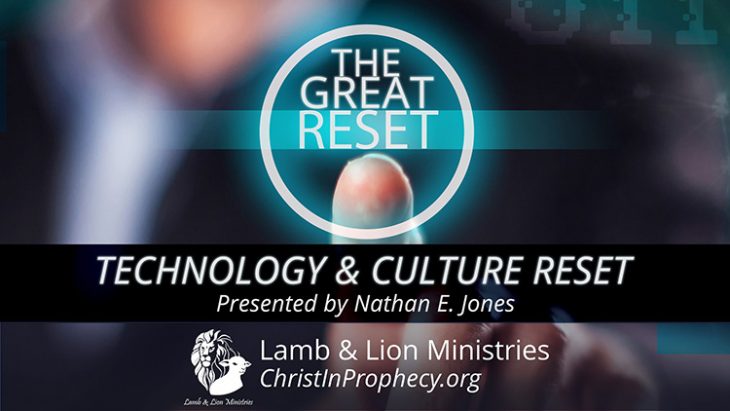The rapid rise of the Globalist agenda that’s bent on forming Satan’s prophesied one-world government is called “The Great Reset.” In these efforts, Satan has been using today’s technologies to unite the world under his new culture and ethos. In the first segment, we began by analyzing how drastically this modern-day tech culture is negatively affecting our vulnerable youth. Then we identified Satan’s five-step strategy in bringing about his one-world government. We will at last end by examining the technological means by which Satan progresses his insidious agenda, specifically the technologies that involve entertainment and security. Finally, we’ll tie all of this series together by identifying just what the prophesied end times culture will look like.
Category 5: Entertainment
This now leads us to the fifth vital category of technologies which keeps people addicted to their smartphones — entertainment applications. Online entertainment takes the form primarily of streaming video which includes long and short-form video, gaming, and social media.
Today’s society tends to be visually driven. As a matter of fact, 65% of people learn visually, meaning these visual learners absorb and recall information best by seeing.24 While auditory learners need to hear information and kinesthetic learners need to engage in an activity in order to grasp a concept, visual learners, or spatial learners, obviously learn and remember best through visual aids such as maps, images, pictures, diagrams, mind maps, and most importantly videos.
In today’s world of advanced technology and hi-speed communication, many technologies drive visual learners to on-demand and streaming video. As technologist John Dyer points out, “Technology has become a kind of supra-cultural phenomenon that finds its way into every aspect of our diverse lives.”25 Today’s advanced communications technology has provided a boom in what is known as long-form video produced by the film industry. As media culture expert Steve Turner notes, “Film supplies more widespread cultural references than any other art form” and “movies provide a shared reference point.”26 Film and movies provide an unparalleled opportunity to connect to an increasingly visually-driven, story-oriented culture and then reshape it to the storytellers’ point of view.
To meet the rabid appetite for all things video, streaming video companies such as Netflix, Hulu, HBO Go, Disney Plus, Amazon Prime Video, Sling TV, Crackle, and many others have risen in prominence. Streaming devices connected to one’s smart television such as Apple TV, Kindle Fire Stick, Roku, and Chromecast and through mobile apps compete to make cable box executives fearfully contemplate their industry’s impending demise. For only a few dollars a month, subscriptions to these services open up vaults of libraries of movies and films (even that ever-elusive Disney vault).
While long-form videos, such as films and movies, certainly are making their impact on the modern culture, the high production level, excessive costs, and limits of bandwidth on mobile devices have placed such media out of reach of most aspiring filmmakers and film-watchers. The solution to this dilemma has been the advent of what is called short-form video, meaning video that runs a few minutes in length and allows for amateur production quality. Pastor Craig Loscalzo notes that this media is perfect for engaging with the mosaic style of thinking used by the Post-Modernist, meaning they draw conclusions from seeing the parts rather than seeing the whole because they are a “sound-bite driven culture” who have neither endurance nor lengthy attention spans.27
Where can one best find short, unprofessional yet widely accepted short-form video? The answer is YouTube and TikTok, the most popular online video platforms in the world. As one marketing expert cleverly noted, “YouTube is the future of entertainment. It has been for a few years now.”28
Since YouTube’s launch on April 23, 2005, by three former PayPal employees, YouTube’s ease of use and easy accessibility has led to its exponential growth, so much so that search engine leader Google bought YouTube for $1.65 billion.29 Some two billion users — almost a third of the world’s population — access YouTube every month. Some 79% of Internet users claim that they have a YouTube account to access videos available in 80 different languages.30
Because 90% of U.S. Internet users ages 18 to 44 years accessed YouTube, Gen-Zs have also been dubbed the “YouTube Generation.” For this rising generation, the standard scheduled half to full hour television watching has become a relic of the past. The YouTube Generation uses their smartphones to hop from one short-form video to the next to the next to consume a mere portion of the 720,000 hours of video uploaded daily to YouTube’s platform.31 Of the average 40.77 exabytes of mobile traffic every month, 29.15 petabytes of that monthly traffic come from video.32 Countless hours every day are devoted to YouTube video consumption. And, increasingly, Christian and Conservative content, content such as what Conservative spokesman Dennis Prager’s PragerU produces and lost a lawsuit defending, are increasingly coming under censorship as Google decides what people should or shouldn’t watch.
The $100 billion global gaming industry has also taken the mobile world by storm, having steadily transitioned away from console devices such as the Xbox and Playstation to the smartphone. Gaming apps such as Pokémon GO, Minecraft, Snapchat Games, and Hearthstone engage primarily males in their massively multiplayer online role-playing games (MMORPGs) across top gaming countries such as Germany, Japan, the U.S., Singapore, and South Korea. According to one 2019 Forbes poll, gamers are playing on their smartphones an average of seven hours each week, but that has been increasing 20-25% every year.33 The global gaming community transcends national borders, living within virtual worlds and sharing common experiences and speaking in a common vernacular.
Along with video watching and gaming, social media has added an average of 2 hours and 24 minutes per day spent with one’s smartphone multi-networking across an average of 8 social networks and messaging Apps.34 Active social media users, primarily female, have passed the 3.8 billion mark on popular platforms such as Facebook, Twitter, Pinterest, Snapchat, WeChat, Instagram, LinkedIn, and a plethora of others.35 With 83% of 12-15-year-olds owning their own smartphone, 69% interacting over social media, and 71% taking their phones and “friends” to bed with them every night, social media has become the primary means of communications among youth, even preferred alarmingly over in-person conversation.36
Category 6: Security
This sixth and last vital category of technologies inherent in the smartphone involves security measures. These are the technologies that on the surface are meant to keep the individual safe, but are really about keeping society “safe.”
There are those security software packages and firewalls which protect phones from the ever-increasing threat of cyber-warfare and identity thieves. But, there are also those hyper-advanced technologies that continually track where a smartphone and hence the smartphone’s user is at all times via the Global Positioning System (GPS) tied to satellite-based radio navigation and tower pinging tied to cell tower locations. Though GPS has conveniently replaced the paper map, our phones know exactly where we are standing at any moment. Location tracking constantly sends data back to big tech companies such as Facebook, Apple, Microsoft, Amazon, Google, and then-unknown third parties in order to target you with mobile ads. And, you permitted them to track you through data-sharing policies buried deep within pages and pages of privacy policies and terms of agreements. Apple even tracks personal calls, emails, and texts in order to “prevent fraud” and to rate the owner with a “trust score.”37 Personal privacy left the building as soon as online privacy did.
These security technologies also include the Orwellian-realized world of constant monitoring via cameras, microphones and smart assistants such as Siri, Amazon Echo, and Google Home, which are ever listening. For example, ever since 2014 when Amazon unveiled the Echo speaker featuring Alexa, its voice-activated virtual-assistant software, armies of low-paid Amazon employees have been listening in and transcribing people’s conversations, often gleaning very personal security information.38 This is not one isolated instance by one company, but has been reported across all tech companies under the banner of “improving their services.”
And, when totalitarian governments get involved in security monitoring, you get China’s Social Credit Score. The closest system we have today to the Antichrist’s Mark of the Beast is China’s Social Credit Score, which has already been instituted in their more populated cities. China’s Communist government has infiltrated millions of cameras everywhere in order to spy on its citizens. Computer algorithms then rate the citizen’s allegiance to the government, granting benefits to those who are more loyal and restrictions on those the computer deems as not being patriotic enough. Many other countries are interested in adopting China’s system, and will inevitably be implemented worldwide.
And, as home security systems and home devices become more “smart” and interconnected to the Internet of Things (IoT), with the master controller being one’s smartphone, the threat grows of a shady outside entity being able to gain control and monitoring of one’s own home over their very own security system. For instance, Amazon’s Ring doorbell camera system was discovered being monitored by company engineers over unencrypted live video feeds.39 Amazon even wants to tie their Ring doorbells into facial recognition and has allowed police forces to use these home cameras as part of their surveillance network.
The very home security devices which keep the robbers out can also keep the homeowners in a monitored prison of their own making.
Tying It All Together
I have been presenting the argument that Satan’s final step towards realizing his goal of world domination and global adulation rests on globalizing the world under his new ethos and culture. Theology professor William Edgar defines culture as “something like a key to the beliefs and customs of a particular society, with a view to changing them.”40 With the advent of today’s vast technologies, the pinnacle being the smartphone, Satan has found the perfect device in which to mold his new unifying ethos and culture.
What then characterizes today’s brave new culture? Media expert Steve Turner would characterize it as “pop-culture” and notes just how vastly it suffuses just about every part of the lives of everyone everywhere.41 He warns that the driving spiritual forces behind much of pop-culture are intent on altering the perceptions of the outgoing culture, often negatively towards the God of the Bible and Christianity. “When we suspect that culture has an agenda, we are naturally more guarded. When we think that it’s only there to tickle us, we roll over and start purring… we are vulnerable to spiritual corruption when not alert.”42
The result has been a transition of our society away from a historical Modernist logic-based thinking to a Post-Modernist relativistic feelings-based post-Christian era. Evangelism expert Rick Richardson describes the characteristics of this brave new Post-Modern culture as including a common belief that people are their own gods, they often engage in identity politics, they are rampantly distrustful of authority, they hold a general belief that love rules, they have an overt fear of “the patriarchy,” they readily discard whatever came before, and they tend to view Christians as self-serving.43 This is Satan’s new ethos, carefully indoctrinating the masses worldwide by their ever-present and ever-watching smartphones, thus creating a new global culture.
“But know this, that in the last days perilous times will come: For men will be lovers of themselves, lovers of money, boasters, proud, blasphemers, disobedient to parents, unthankful, unholy, unloving, unforgiving, slanderers, without self-control, brutal, despisers of good, traitors, headstrong, haughty, lovers of pleasure rather than lovers of God, having a form of godliness but denying its power.” (2 Timothy 3:1-5)
Pro-Humanist, anti-Christian, “having a form of godliness but denying its power” — the end of days culture Paul warned Timothy has at last come. These deniers of the one true God, Paul promises, folly will be made manifest to all.
But, you Christian, “know the Holy Scriptures, which are able to make you wise for salvation through faith which is in Christ Jesus” (2 Timothy 3:15).
References
24. Aultman College, “Understanding Your Learning Styles” (accessed March 2020), http://www.aultmancollege.edu/Files/Understanding-Learning-Styles.pdf.
25. John Dyer, From the Garden to the City: The Redeeming and Corrupting Power of Technology (Grand Rapids: Kregel, 2011), p. 22.
26. Steve Turner, Popcultured: Thinking Christianly About Style, Media and Entertainment (Downers Grove: Intervarsity, 2013), p. 60.
27. Craig Loscalzo, Apologetic Preaching: Proclaiming Christ to a Postmodern World (Downers Grove: InterVarsity, 2000), p. 10-12.
28. Maryam Mohsin, “10 YouTube Stats Every Marketer Should Know in 2020,” Oberlo, (accessed March 2020), https://www.oberlo.com/blog/youtube-statistics.
29. Ibid.
30. Ibid.
31. Ibid.
32. “Internet Stats & Facts (2020).”
33. Kevin Anderton, “Research Report Shows How Much Time We Spend Gaming,” Forbes, (March 21, 2019), https://www.forbes.com/sites/kevinanderton/2019/03/21/research-report-shows-how-much-time-we-spend-gaming-infographic/.
34. Dave Chaffey, “Global social media research summary 2020,” Smart Insights, (April 17, 2020), https://www.smartinsights.com/social-media-marketing/social-media-strategy/new-global-social-media-research/).
35. Ibid.
36. Ibid.
37. Kim Komando, “How to stop your smartphone from tracking your every move, sharing data and sending ads,” USAToday, (February 14, 2019), https://www.usatoday.com/story/tech/columnist/komando/2019/02/14/your-smartphone-tracking-you-how-stop-sharing-data-ads/2839642002/.
38. “Silicon Valley Is Listening to Your Most Intimate Moments,” Bloomberg Businessweek, (December 11, 2019), https://www.bloomberg.com/news/features/2019-12-11/silicon-valley-got-millions-to-let-siri-and-alexa-listen-in.
39. Andy Meek, “Amazon-owned Ring has reportedly been spying on customer camera feeds,” BGR, (January 10, 2019), https://bgr.com/2019/01/10/ring-camera-customer-feeds-accessed-creepy-privacy-violation/.
40. William Edgar, Created and Creating: A Biblical Theology of Culture (Downers Grove: IVP Academic, 2017), p. 6, 233.
41. Steve Turner, Popcultured: Thinking Christianly About Style, Media and Entertainment (Downers Grove: Intervarsity, 2013), p. 8.
42. Ibid.
43. Rick Richardson, Evangelism Outside the Box: New Ways to Help People Experience the Good News (Downers Grove, IL: InterVarsity Press, 2000), p. 23.







